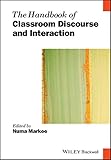The handbook of classroom discourse and interaction / Edited by Numa Markee.
By: Markee, Numa.
Material type: BookSeries: Blackwell handbooks in linguistics: 115.Publisher: Malden, MA : Wiley-Blackwell, [2015]Edition: First Edition.Description: 1 online resource.Content type: text Media type: computer Carrier type: online resourceISBN: 9781118531167 (Adobe PDF); 1118531167 (Adobe PDF); 9781118531211 (ePub); 1118531213 (ePub); 9781118531242; 1118531248; 1118531124; 9781118531129.Subject(s): Language and languages -- Study and teaching | Conversation analysis -- Study and teaching | Interaction analysis in education | Classroom environment | Classroom learning centers | LANGUAGE ARTS & DISCIPLINES / Linguistics / General | Språk | Samtalsanalys | DidaktikGenre/Form: Electronic books. | Electronic books.Additional physical formats: Print version:: Handbook of classroom discourse and interactionDDC classification: 418.0071 Other classification: LAN009000 Online resources: Wiley Online Library
BookSeries: Blackwell handbooks in linguistics: 115.Publisher: Malden, MA : Wiley-Blackwell, [2015]Edition: First Edition.Description: 1 online resource.Content type: text Media type: computer Carrier type: online resourceISBN: 9781118531167 (Adobe PDF); 1118531167 (Adobe PDF); 9781118531211 (ePub); 1118531213 (ePub); 9781118531242; 1118531248; 1118531124; 9781118531129.Subject(s): Language and languages -- Study and teaching | Conversation analysis -- Study and teaching | Interaction analysis in education | Classroom environment | Classroom learning centers | LANGUAGE ARTS & DISCIPLINES / Linguistics / General | Språk | Samtalsanalys | DidaktikGenre/Form: Electronic books. | Electronic books.Additional physical formats: Print version:: Handbook of classroom discourse and interactionDDC classification: 418.0071 Other classification: LAN009000 Online resources: Wiley Online Library "The Handbook of Classroom Discourse and Interaction is an authoritative reference work exploring the latest research, methodologies, and theories related to classroom language, teaching, and learning"-- Provided by publisher.
Includes bibliographical references and index.
Machine generated contents note: Table of contents 1. Preliminary matters 1. Introduction: Classroom discourse and interaction research (Numa Markee) 2. Research Methodologies and Assessment Overview 2. Developing A Multi-faceted Research Process: An Ethnographic Perspective for Reading Across Traditions (Judith Green, Maria Lúcia Castanheira, Audra Skukauskaite, and John Hammond) 3. Understanding classroom discourse and interaction: Qualitative Perspectives. (Audra Skukauskaite, Denise Ramon, Jessica Rangel and Lisa Rodriguez). 4. Experimental perspectives on classroom interaction (Mike Long) 5. Shifting trends in the assessment of classroom interaction (Marta Anton) 3. The Educational Tradition Overview 6. Discourse and Learning in Contexts of Educational Interaction (Carl Fredericksen and Janet Donin) 7. Can Neo-Marxist and post-structural theories in education inform each other? Using genre approaches to bridge the gap (Ross Collin and Michael Apple) 8. The role of talk in group based activity in language classrooms (David Bloome) 9. The sequential analysis of instruction (Oskar Lindwall, Christian Greifenhagen and Gustav Lymer) 4. The Cognitive-Interactionist Tradition Overview 10. The role of tasks as vehicles for learning in classroom interaction (YouJin Kim) 11. Comprehensible input and output in classroom interaction (Sue Gass) 12. An interactionist approach to learner-learner interaction in second and foreign language classrooms (Melissa Bowles and Rebecca Adams) 13. The relative effectiveness of corrective feedback in classroom interaction (Roy Lyster) 5. The Sociocultural Theory Tradition Overview 14. From inter-action to intra-action: the internalization of talk, gesture, and concepts in the second language classroom (Eduardo Negueruela-Azarola, Prospero García and Kimberly Buescher) 15. Classroom Discourse and Interaction in the zone of proximal development (Holbrook Mahn) 16. The emergence of sociolinguistic competence in second language classroom interaction (Remi Van Compernolle) 17. Expert-novice relationships in second language classroom interaction (Steve Thorne and John Hellerman) 6. The Language Socialization Tradition Overview 18. The role of language socialization in heritage language classroom interaction (Agnes He) 19. Language socialization across learning spaces (Jin Sook Lee and Mary Bucholtz). 20. Language and literacy socialization for immigrant and international students in educational contexts (Patricia Duff and Tim Anderson) 21. A language socialization perspective on identity work of ESL youth in a superdiverse high school classroom (Steven Talmy) 7. The Conversation Analysis Tradition Overview 22. L2 classroom interaction as a complex adaptive system (Paul Seedhouse) 23. Institutional talk-for-learning beyond the classroom (Gabriele Kasper and Younhee Kim) 24. Documenting change across time: longitudinal and cross-sectional CA studies of classroom interaction (Simona Pekarek-Doehler and Virginie Fasel Lauzon) 25. CA-for-SLA studies of classroom interaction: Quo vadis? (Numa Markee and Silvia Kunitz) 8. The Critical Theory Tradition Overview 26. Multilingual classroom discourse as a window on wider social, political and ideological processes: Critical ethnographic approaches (Marilyn Martin-Jones) 27. Power, resistance and second language learning (Elizabeth Miller) 28. Seeing "language and development" play out in classroom interaction (Roslyn Appleby) 29. The social construction of inequality in and through interaction in bilingual classrooms (Luisa Martín Rojo) 9. Final Words 30. Where does research on classroom discourse and interaction go from here? (Numa Markee) Appendix Transcription conventions Author index Subject index .
Description based on print version record and CIP data provided by publisher.



There are no comments for this item.